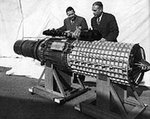It just has been an idea, nothing to upset us.
Good.
In that case, had you thought of eliminating the piston engines altogether?

I know the jet powerplant you envisage is 'small', so would two suffice? Arranged in a stacked position?

I guess you would have to redesign the tail to prevent scorching? I understand that Lockheed had experimented with this to reduce flutter (unsuccessfully).









